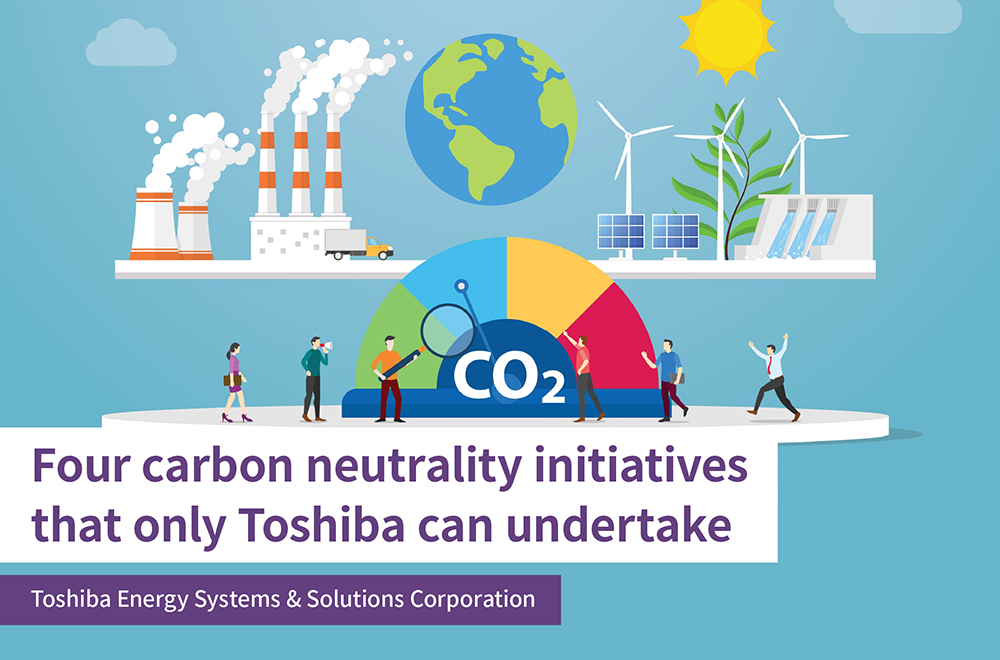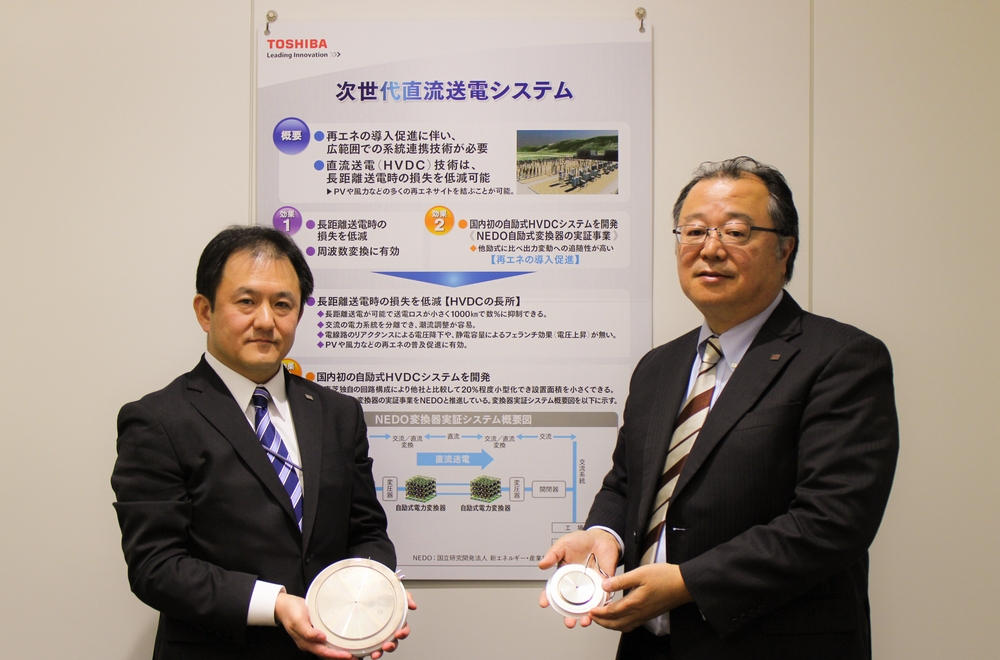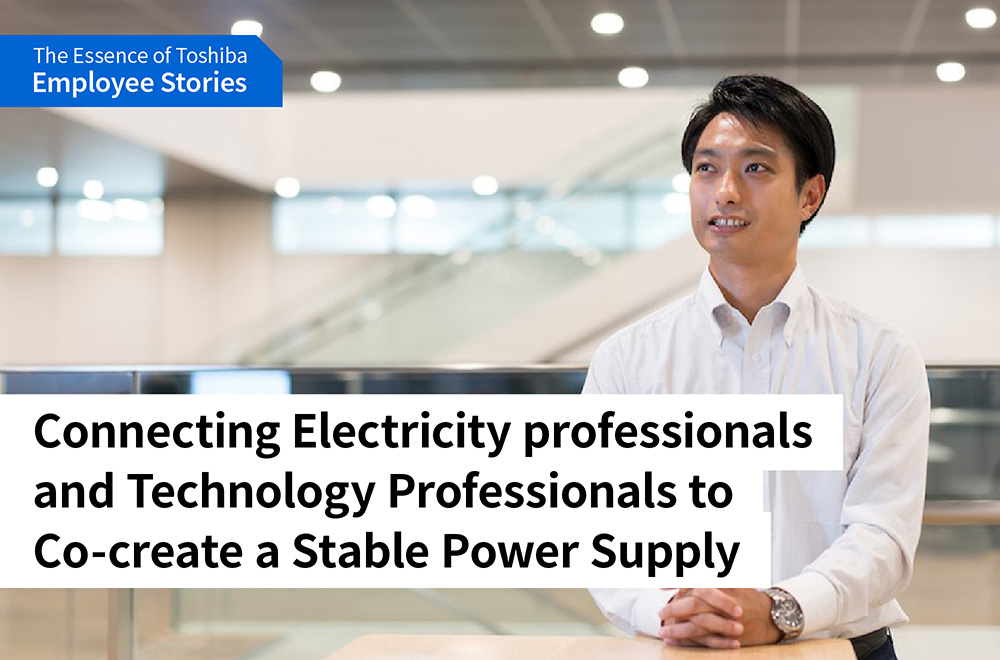Toward Sustainable Electric Power Infrastructure, Part 2 -Toshiba’s Technology Makes the Difficult Possible, the Resolve of a Leading Company
2023/02/24 Toshiba Clip Team
- Companies that support power infrastructure must contribute to carbon neutrality
- The challenge of downsizing equipment made three times larger by carbon-neutral gases
- Using digital technology and AI to boost power infrastructure reliability
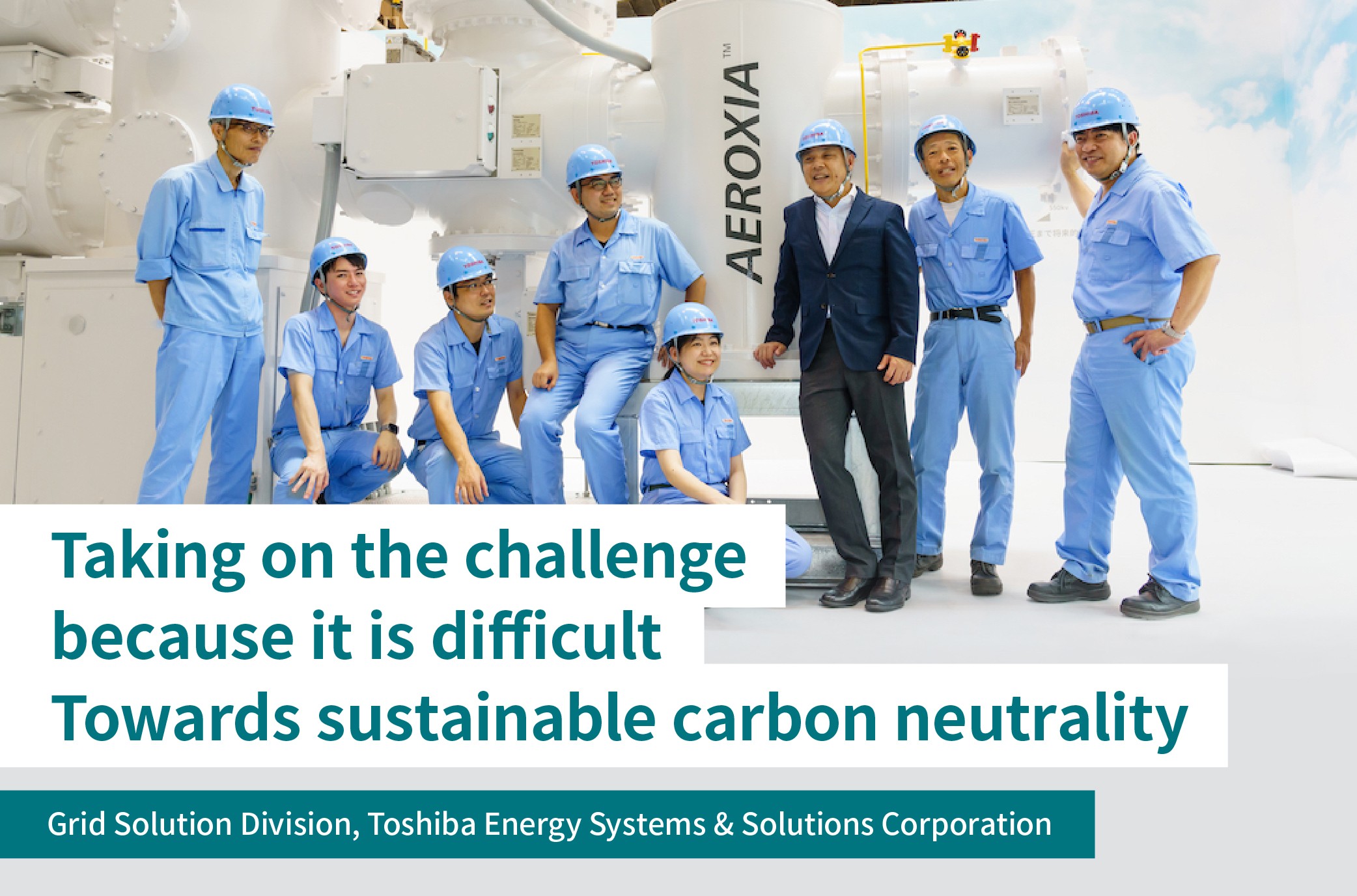
L. to R., Norimitsu Kato, Tomoya Onishi, Shuhei Takao, Toru Koike, Yuko Imazawa,
Toshiyuki Uchii, Hideaki Shirai, Akihisa Mukaida
In June 2022 torrential rains and flooding in southern China caused damage that affected tens of thousands of people, and in summer the situation took a turn for the worse with successive heat waves and drought. The IPCC*1 has declared that it is “indisputable” that weather events like these are part of climate change due to human activities. This leaves countries worldwide with no choice but to take urgent action, and the world is making major moves toward becoming carbon neutral and cutting net greenhouse gas emissions to zero and increasing absorption.
*1 IPCC: the Intergovernmental Panel on Climate Change. It organizes, collates and reports on research into global warming.
Climate change is strongly linked to increasing emissions of greenhouse gas, which drive global warming. There are a number of greenhouse gases, and one, sulfur hexafluoride (SF₆), plays an important role in gas insulated switchgear (GIS), a component of electric power transmission and distribution infrastructure. However, while very useful, SF₆, volume for volume, trap almost 25,000 times more heat in the atmosphere than CO₂. That explains why a search for alternative GIS gases is now underway around the world.
A GIS is equipment that functions like a switch, to turn flows of electricity on and off. It uses the excellent electrical insulating characteristics of SF₆ (gas insulation) to squelch sudden surges in voltage due to lightning strikes and abnormal power flows in transmission and transformation facilities, such as switching stations and substations. It protects transmission infrastructure by disconnecting equipment, and is essential for safe, stable electricity supply.
In the first part of this two-part article, we looked at the considerations that lead up to Toshiba’s development of a GIS that using natural origin gases. In this second part, we take you behind the scenes of the development process and look at future prospects.
Taking on difficult challenges, the responsibility of a company supporting power infrastructure
Moves to regulate SF₆ are making progress, most notably Europe and the United States. This is the background to the early development of a GIS that uses an alternative electrical insulating gas, covered in the first article. That article also explained that maintaining SF₆’s level of insulation with an alternative gas would require much more gas, and a much larger GIS. Toshiyuki Uchii of Toshiba Energy Systems lays out this frustrating dilemma.
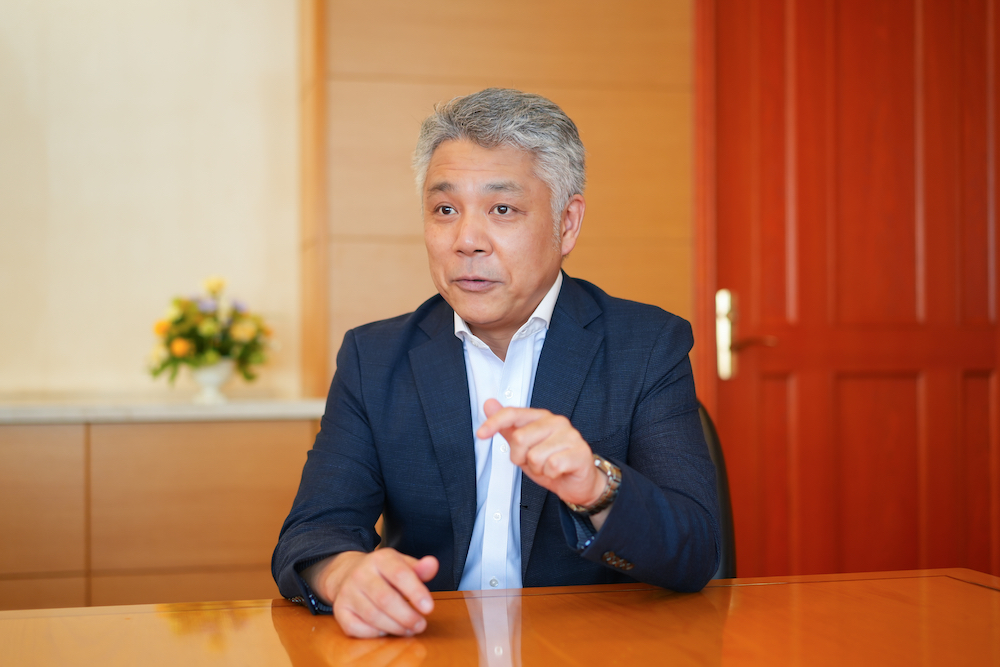
Toshiyuki Uchii, Fellow, Power & Substation Systems Engineering Dept., Grid Solution Div.,
Toshiba Energy Systems & Solutions Corporation
“If you design a GIS that uses gases with little greenhouse effect, you have to factor in that they are only one-third of electrical insulating performance, and so you end up with equipment about three times the size. Naturally, it would be more expensive, installation locations would be limited, and it would not be accepted by society as is.”
Despite this, Uchii went ahead with development work, as he explains: “We decided to develop a GIS with natural origin gas, that is safe and reliable, and that can be used to replace old SF₆ equipment. Yes, it was a difficult technical development, but I believed that we could do it if we mobilized the powers of Toshiba’s engineers.”
As Uchii says, it would be difficult, but if successfully completed, it would be certain to contribute carbon neutrality and to attract attention, in Japan and overseas, and so the decision was made. Uchii put together the team pictured at the head of this article, a seven-strong group that pooled their expertise with his in a new GIS development project.
What is being proposed as an alternative gas to SF₆?
In parallel with Uchii’s project team, the industry also made a move, with the “SF₆ Alternative Gas Study Group”*2. Established in 2016, it researched and studied alternatives to SF₆, and proposed seven requirements for alternative gas. These included, in respect of safety during handling, a toxicity equivalent to SF₆; a stable supply from multiple companies; and a scope of application that would eventually make it be possible to handle rated voltages up to 550kV, the highest in Japan.
*2: A study group drawn from across Japan, comprising 11 domestic electric power companies, 7 switchgear manufacturers, 6 universities, the Central Research Institute of Electric Power Industry, the Transmission & Distribution Grid Council (observer), and the Japan Electrical Manufacturers’ Association (observer).
It was the first change in 50 years to insulating media used for high voltage switchgears. Numerous alternatives had been proposed, and the result was confusion. In the midst of all this, Toshiba stayed true to natural origin gases that are safe and secure, in both environmental and operational terms. There were good reasons for this. Natural origin gases clearly stacked up best against the seven requirements of the SF₆ Alternative Gas Study Group, and beyond that Toshiba knew that once a GIS is introduced, it is in use typically for 40 to 50 years, and the engineering team did not want to use anything with the risk of changing to unstable or poisonous material during life time.
After rounds of trial-and-error tests by a number of companies, results were consolidated into two main approaches. One group has adopted natural origin gases, while the other is working with artificial fluorinated gases with lower global warming potential than SF₆. In November 2021, the former group, 11 switchgear manufacturers around the world, made a joint announcement of their intention to develop a GIS using natural origin gases.
At this point neither technology is equivalent to SF₆. There are clear disadvantages to using another fluorinated gas: a global warming potential about 500 times that of CO₂; toxicity; and a risk of future restrictions on use. However, equipment that relies on natural origin gases delivers inferior gas insulation performance, and any extension of current technology will inevitably lead to larger equipment. However, there is the possibility that improvements and advances in design technology can result in smaller GIS in future, and many manufacturers still have their sights set on natural origin gases. Of course, Toshiba is one of them.
How to keep the size to less than three times that of current GIS
This is the landscape in which Toshiba agreed to team up with Meidensha Corporation, another company committed to natural origin gases. Meidensha’s wealth of experience lies in the development, manufacture, and sale of circuit breakers that use vacuum-interrupting technology (vacuum circuit breaker, VCB), and the two companies recognized that joint development would allow them to accelerate adoption of a new GIS with natural origin gases. Combining the electrical insulating technologies of these gases with the advantages of vacuum circuit breakers achieved both size reductions and a high current interrupting capability.
However, the development curve was steep. Simply replacing SF₆ with a natural origin gas meant larger equipment and reduced performance. There had to be technological fix to overcome this, and Toshiba had to find it. To find out how that went, we spoke to Toru Koike of Toshiba Energy Systems & Solutions Corporation.
As the leader of the development and design team, Koike explained as follows; “Our first concern was to control the electric field in the metal conductor that is subject to high voltages. If there are any metallic particles on its surface, they become weak points that produce unexpected discharges. We prevented this by coating the conductor surface, covering the protrusions and improving the electrical insulating performance of the natural origin gases.”
As Koike goes on to explain, this is no ordinary coating material or process: “It has to be tough and reliable enough. It must maintain its quality for at least 50 years without peeling or oxidizing, even in high temperatures and high-pressure conditions. We had to develop the optimal coating material, and we also had to define the coating method.
“Our second concern was the structure of the switchgear. This was completely redesigned to realize the high energy current switching that power utilities require for GIS. Although the physical properties of SF₆ and the gases used differ greatly, we reached our performance targets by using the know-how Toshiba has built up over a half-century of SF₆ GIS development, plus the latest analysis and design technologies.”
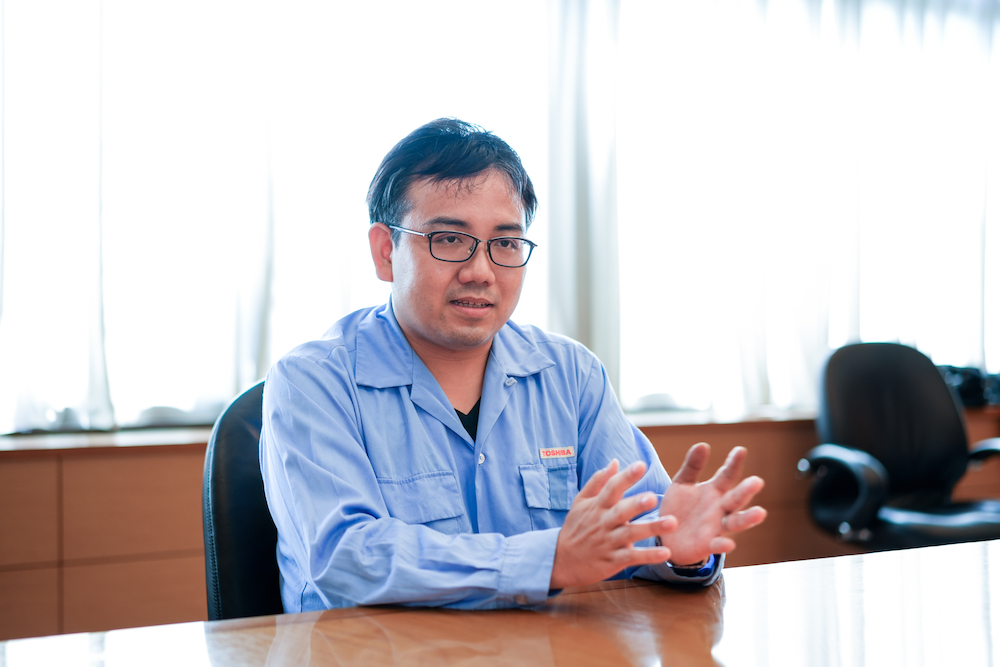
Toru Koike, Specialist, Switchgear Design & Development Group, High Voltage Switchgear Dept., Hamakawasaki Operations, Grid Solution Div., Toshiba Energy Systems & Solutions Corporation
The result of incorporating these technologies to improve insulation and current switching is a new GIS about 1.5 times the size of an SF₆ GIS, not three times the size. In other words, at only half the expected size, it is suitable for projects to replace older SF₆ equipment, and also for space-restricted underground substations.
Toshiba announced the first order for new GIS when it unveiled the new equipment on July 12, 2022. The priority now is to increase the number of installations in Japan. TEPCO Power Grid Inc., the company that will install the new 72kV GIS, expressed its expectations of Toshiba’s natural origin gas GIS in a statement.
“As the world strives to achieve carbon neutrality, reduced use of SF₆ gas is an important item on the agenda for the power transmission and distribution sector. We believe that our decision to introduce Japan’s first GIS for electric power utilities using natural origin gases is the first major step toward addressing this issue. We have high hopes for future technological developments that will deliver both reliability and compact size, as well as cost reductions.”
Interest in ending dependance of SF₆ is not confined to Japan. Companies overseas that are sensitive to climate change are already inquiring about the project, and Toshiba is considering moving into overseas markets.
Adding the strengths of digital technology and AI
As with any social infrastructure, a major issue for the new GIS is the need for advanced maintenance and labor-saving measures that can curb the costs of maintaining and renewing equipment while maximizing functionality. Toshiba’s response to this challenge is a concept it calls the digital substation, built around data sensing and AI analysis technologies. Sensors installed in the GIS collect critical data on current, gas pressure and temperature, all of which are aggregated into a whole by monitoring equipment. Using its GIS operational know-how and the data it has already accumulated, Toshiba has developed a system for centralized remote monitoring of the entire GIS that provides information on life-time diagnosis and trend analysis. This creates value in areas such as early detection of equipment abnormalities, and prompt confirmation of necessary information and measures in the event of a problem.
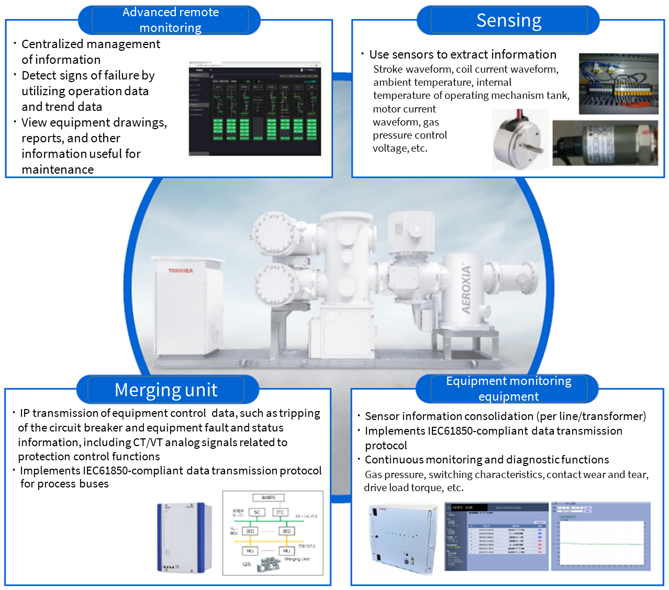
Toshiba adds value to GIS with its digital substation concept
Toshiba has also added the power of AI to the use of these information assets. The AI diagnostics it has developed for the GIS learns from the sensor waveform data acquired under normal operating conditions. It can detect subtle signs of abnormality as they start to appear, signs that are difficult for people to identify, and automatically scores the operating status of the GIS. Until now, periodic GIS maintenance was necessary, but with these new technologies it can now be performed as appropriate through GIS status visualization. The content and frequency of inspections can be streamlined.
The brand name for Toshiba’s new GIS is AEROXIA. The name is derived from two words, “aero,” for air, denoting the natural origin gas, and “axia” which means value in Greek. It represents the project team’s intent to create sustainable value that advances carbon neutrality in power grids.
Utilizing natural origin gases, developing a new GIS, harnessing the power of digital technology and AI… One characteristic of Toshiba is that refines advanced technologies to meet the needs of its customers and society. However, at this point the company has so far taken only the first step toward realizing carbon neutrality in power transmission and distribution systems, and there are still many challenges to overcome.
Uchii echoes this sentiment: “Obviously, this is only the beginning, and there are still many challenges on the way to fully replacing SF₆ equipment. However, Toshiba has a responsibility to society to protect the power infrastructure, and one of the things that makes doing that worthwhile is that it is difficult. But no matter how difficult it may be, we will anticipate the world’s needs, develop technologies, think things through with our customers and other stakeholders, and introduce new products and services. This is the Toshiba way.
“The things we have to take on in the development process for the new GIS includes further size reductions and support for higher voltages. With a determination to help to create the next 50 years, we will advance our technology and contribute to carbon neutrality.”
![]()
Related Links
*This section contains links to websites operated by companies and organizations other than Toshiba Corporation.
TOSHIBA AEROXIA Brandbook
Transmission & Distribution | Toshiba Energy Systems & Solutions





